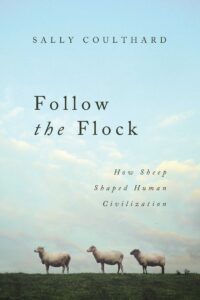SDA Book Club: “Follow the Flock” reviewed by Faith Hagenhofer
September 2, 2022
Follow the Flock: How Sheep Shaped Human Civilization by Sally Coulthard
Among the many book reviewers for Surface Design Journal, I am on the fiber beat. I continue to be fascinated by the physical materials and processes that form the foundation of all textiles and the books written about them. Further, I am on the wool beat, a niche if ever there was one. This is, at least in part, due to my being a shepherd.

As such, I had the small misfortune to need a visit to the veterinarian today; my young Gotland X Blue Faced Leicester ewe lamb is ailing. As the doctor and I were discussing treatments, I asked why more information wasn’t available on some medications that could only be used off label, since their efficacy for sheep was unknown. He said it was due to a lack of research, and sheep are considered “secondary supplemental farm animals.” I was speechless. Sheep and their wool-growing lives are, and have been, utterly fundamental for humans. And so argues author and fellow shepherd Sally Coulthard in her new book, Follow the Flock. In a chapter on Gansey sweaters and clan tartans, Coulthard refers to “reinventing the past through the story of wool.” Follow the Flock is not a reinvention so much as an unearthing.
What is particularly delightful is that this is not aimed at the fiber nerd. M.L. Ryder’s 1983 exhaustive work Sheep & Man and to a lesser extent Alan Butler’s Sheep: The Remarkable Story Of The Humble Animal That Built The Modern World (2010) are those books. Follow the Flock, full of passionately retold histories, is for the general reader.
Each chapter addresses an aspect of human endeavor, takes the reader back to the time when an intersection with sheep was pivotal and tells tales that bring us to our present. The specifics are British, but the parallels are international. Thus, sheep and wool are the central hub of the book from which subject-specific spokes proceed, covering developments in clothing, shelter, etymology and place naming, religion, the arts, politics, economics, labor, and science. In the chapter that traces the history of children’s labor in the wool mills, and the eventual reforms, Coulthard writes: “Change was slow, frustrated in part by the many members of Parliament and society who had interests in cloth manufacture.” Here, she’s followed the money, and the way in which self-interest can impede necessary societal changes, by looking at the role of labor in wool.
Those of us who are already convinced that wool rules have gotten short shrift, and that the post-polyester years will vindicate us, will enjoy this book. But those folks who like an easy deep dive into an unfamiliar topic in popular non-fiction will find themselves converted, reaching for their Aran sweaters and woollen (sic British spelling) socks, feeling ecologically and environmentally proud in the bargain.
–Faith Hagenhofer
- Publisher: Pegasus Books (buy it here)
- Date: March 2021
- ISBN: 9781643136585
If you’ve read this book, leave a comment and let us know what you think!
Do you have a recommendation for a recent fiber-related book you think should be included in SDA’s Book Club? Email SDA’s Managing Editor, Lauren Sinner, to let her know!
